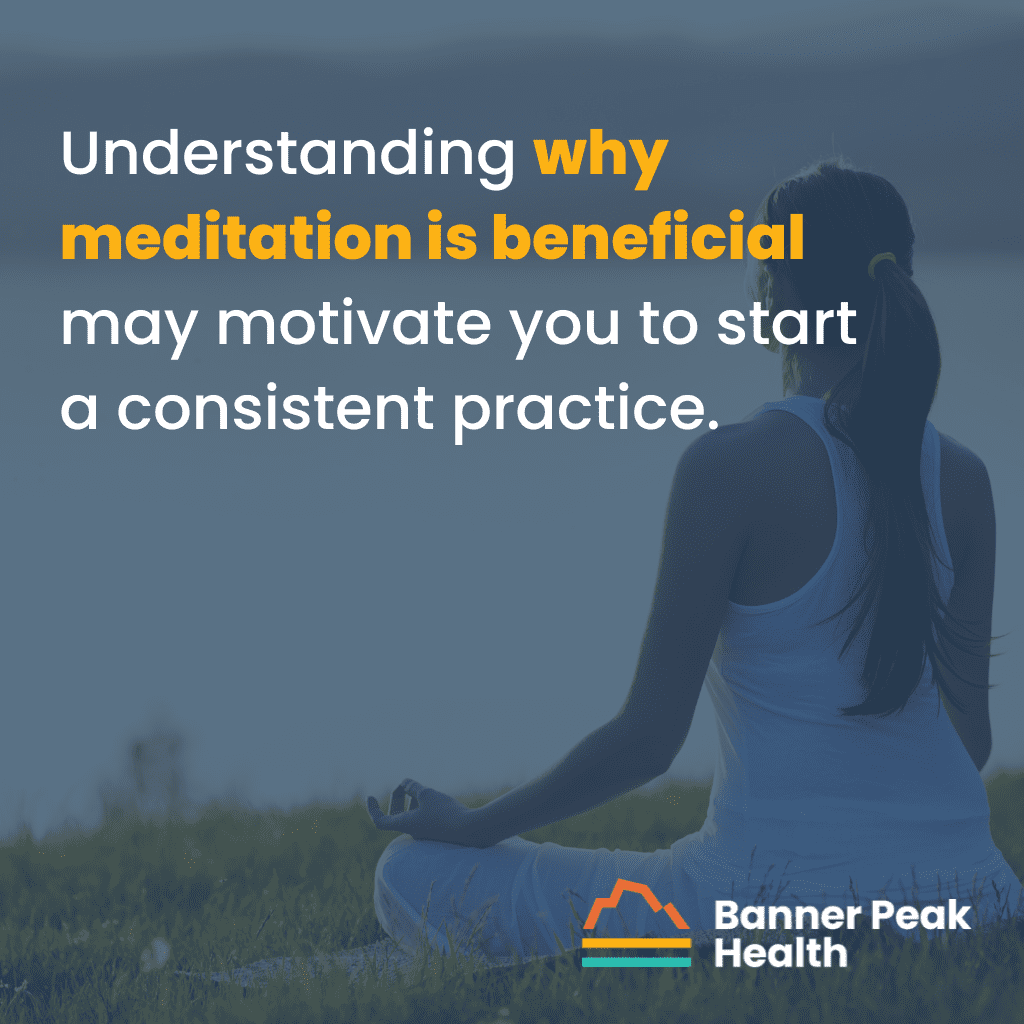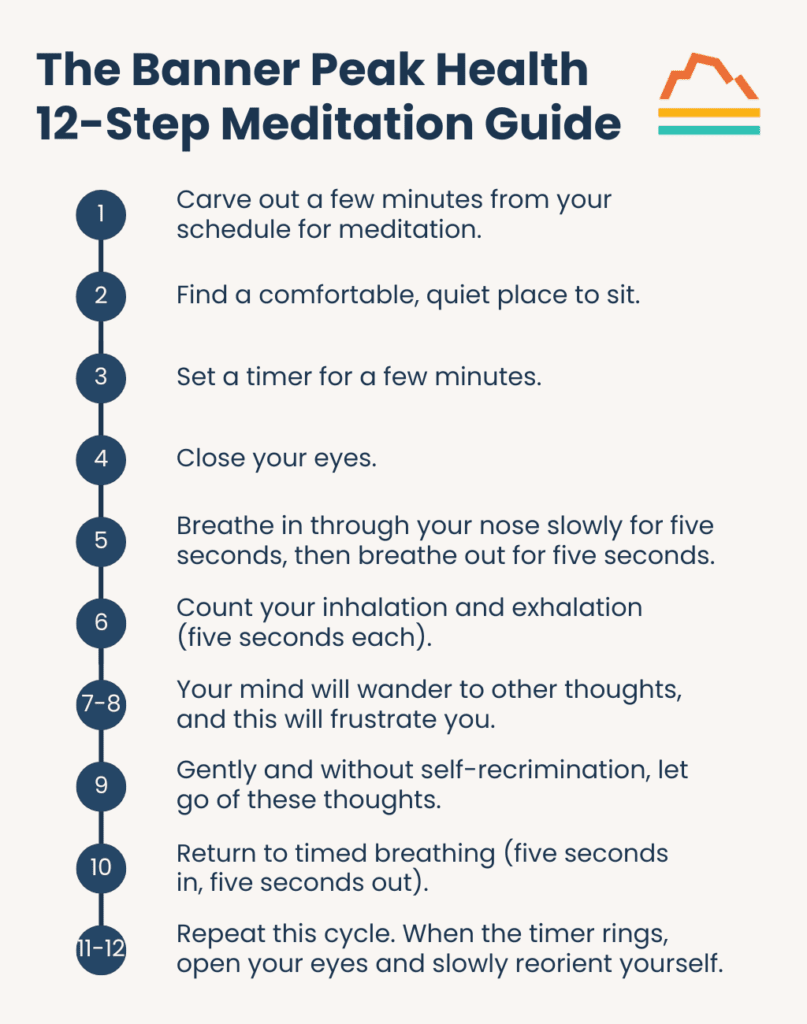I’ve written countless blogs encouraging people to “chill out.” What does this mean?
We’ve discussed heart rate variability (HRV), our need to decrease sympathetic tone in our autonomic nervous system while boosting parasympathetic function. I think of HRV as our “chill out meter” — a tool to measure how well we’re balancing these systems.
Meditation is a powerful technique for helping people chill out. It can change our brain waves, decrease sympathetic tone, and is one of the most robust ways to increase parasympathetic tone. Understanding why meditation is beneficial may motivate you to start a consistent practice.

Most forms of meditation include focused breath work. A study in the January 2025 Journal of Applied Psychophysiology and Biofeedback from Brigham Young University compared different breathing modalities for raising HRV. Researchers examined box breathing (for focus), 4-7-8 breathing (for calmness), and traditional six-breath-per-minute techniques. Their research found the six-breath-per-minute approach most effective for increasing heart rate variability.
With this evidence in mind, we’ve updated Banner Peak Health’s 12-step meditation guide. Instead of simply counting breaths, breathe in through your nose for five seconds, then out for five seconds. This timing achieves the optimal six breaths per minute rate.
The Banner Peak Health 12-Step Meditation Guide
1. Carve out a few minutes from your schedule for meditation.
Before taking your first meditative breath, you’ll need to consciously decide to prioritize meditation and carve out time for it.
We often place our physical and emotional needs at the bottom of our to-do list. It may seem selfish to focus on ourselves when there are more pressing tasks. Not infrequently, I work to convince patients to attend to their own care, not only for themselves but also to have more energy to give to others.
2. Find a comfortable, quiet place to sit.
There’s no special position necessary. Do what feels most comfortable. Remember, you’ll be in this position for several minutes.
3. Set a timer for a few minutes.
You can advance the duration as you improve. As you become more comfortable, you’ll be pleasantly surprised by how fast the time goes!
4. Close your eyes.
It’s that simple. You do it all the time.
5. Breathe in through your nose slowly for five seconds, then breathe out for five seconds.
A slow exhalation stimulates the parasympathetic nervous system (rest and digest).
Stress stimulates the sympathetic nervous system (fight or flight), but slow, deep exhalation suppresses it, allowing relaxation.
6. Count your inhalation and exhalation (five seconds each).
This counting technique helps time your breathing optimally while taking your mind off other worries.
7–8. Your mind will wander to other thoughts, and this will frustrate you.
You may even deem yourself a failure, doomed to never experience the benefits of meditation. Don’t.
Everyone is miserable at meditation because a perfect state of meditation doesn’t exist. Even monks who devote 20 hours per day to meditation humbly refer to their practice as “striving to improve.” That is the valuable lesson of meditation.
9. Gently and without self-recrimination, let go of these thoughts.
In meditation, as in life, we’re imperfect and will make mistakes. We achieve peace of mind by acknowledging this state of being and finding solace in our commitment to giving our best effort without reaching perfection.
Thus, one of the main benefits of meditation is that it teaches us to be kinder to ourselves when dealing with our inevitable failures.
10. Return to timed breathing (five seconds in, five seconds out).
You may lose your count. It’s okay. Start again.
11–12. Repeat this cycle. When the timer rings, open your eyes and slowly reorient yourself.
Try not to anticipate the sound of the timer. Allow yourself to fully immerse in the meditation and enjoy the experience. When it’s over, allow yourself time to adjust.
The Physical and Mental Benefits to Meditation
A growing body of evidence reveals why meditation is beneficial, addressing both physical and psychological benefits to meditation.
There is a direct connection between our thoughts and emotions and our bodies’ biology. Meditation leverages this connection in a very positive direction.
Cortisol is our most prominent stress hormone. Too much can damage every organ system we possess. Fortunately, meditation can reduce cortisol levels, offsetting the rise in our stress-filled lives. This cortisol reduction is just one example of why meditation is beneficial for long-term health.
Researchers studying the brain note that during meditation, the brain’s electrical activity can change with enhanced alpha and beta wave activity, which enhances relaxation and learning function.
There are many additional examples in medical literature of the health-enhancing benefits to meditation, including reducing pain, enhancing sleep, improving memory, and reducing the intensity of illnesses such as irritable bowel syndrome, depression, and post-traumatic stress disorder.
Using Wearables to Measure the Benefits to Meditation Through Biofeedback
The wearable revolution advances rapidly. New devices and features launch every week, giving us unprecedented access to our physiological data.
Biofeedback is using real-time monitoring of physiologic functions to teach voluntary control of those functions. Wearable devices now make this powerful technique accessible to everyone, helping you understand why meditation is beneficial through objective measurements.
The Oura Ring (Banner Peak Health’s preferred wearable) offers a meditation tracking feature that monitors three key physiologic parameters during your session:
- Heart rate
- Heart rate variability (HRV)
- Peripheral skin temperature
This creates a Metric-Driven Empowerment Cycle, where you receive immediate feedback on your meditation’s effectiveness. How does this work in practice?
- Heart rate decreases as you become more relaxed, and sympathetic tone reduces.
- HRV increases as parasympathetic tone improves.
- Finger temperature increases (paradoxically, the more “chill” you are, the warmer your extremities become).
This occurs because sympathetic overdrive constricts your peripheral arteries (cold, clammy fingers), while enhanced parasympathetic tone dilates these vessels (warm fingers).
For optimal data accuracy, here’s a helpful tip: Move your Oura Ring to the finger where it fits most snugly, and keep it as still as possible during meditation. This improves the photoplethysmography measurements (how the LED light passes through your skin).
While using the Oura Ring during my own meditation sessions, I’ve seen up to a four-fold rise in my HRV, confirming that my practice is helping me “chill out.”
Today’s Takeaways
Key benefits to meditation include:
- Reduced stress through lower cortisol levels
- Improved heart rate variability
- Enhanced brain wave patterns
- Better sleep quality
- Reduced anxiety and depression symptoms
- Improved focus and memory
- Physical benefits like pain reduction
- Better emotional regulation
At Banner Peak Health, we continuously review the literature and update our recommendations to incorporate the latest evidence-based techniques. We look forward to working with you and your wearable device to optimize your meditation experience using these state-of-the-art approaches.
Starting with just a few minutes a day, you can change your outlook on life and equip your body to counter stress. The benefits to meditation are clear: from improved physiological markers to enhanced emotional well-being, understanding why meditation is beneficial can motivate you to maintain a consistent practice.
I hope I’ve helped you understand why meditation is beneficial for your health. Please give it a try. Best of luck!

Barry Rotman, MD
For over 30 years in medicine, Dr. Rotman has dedicated himself to excellence. With patients’ health as his top priority, he opened his own concierge medical practice in 2007 to practice medicine in a way that lets him truly serve their best interests.




